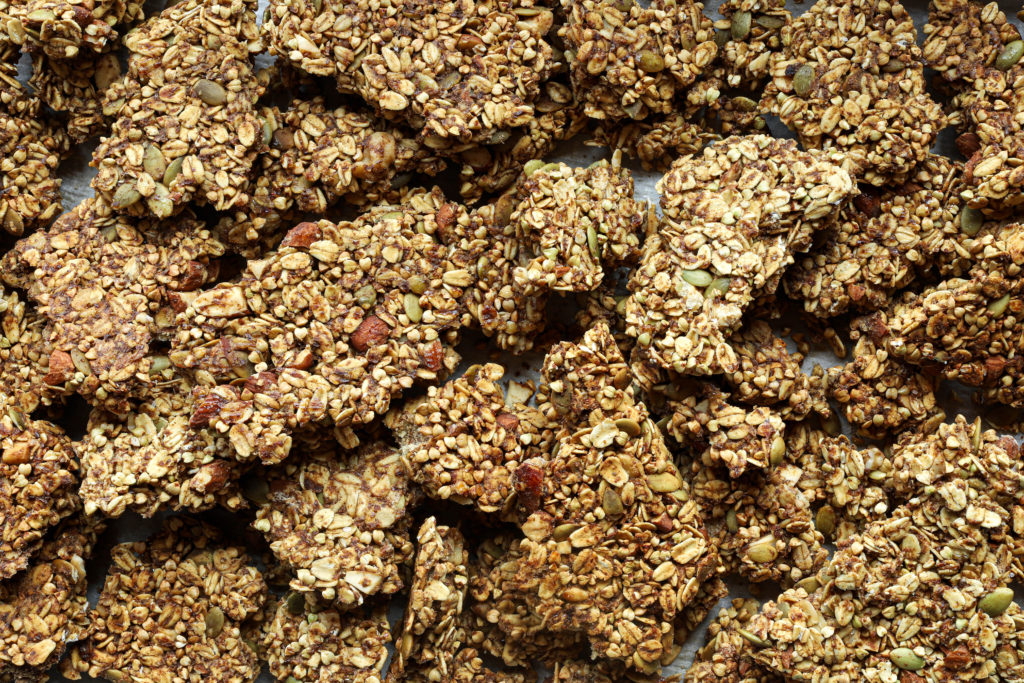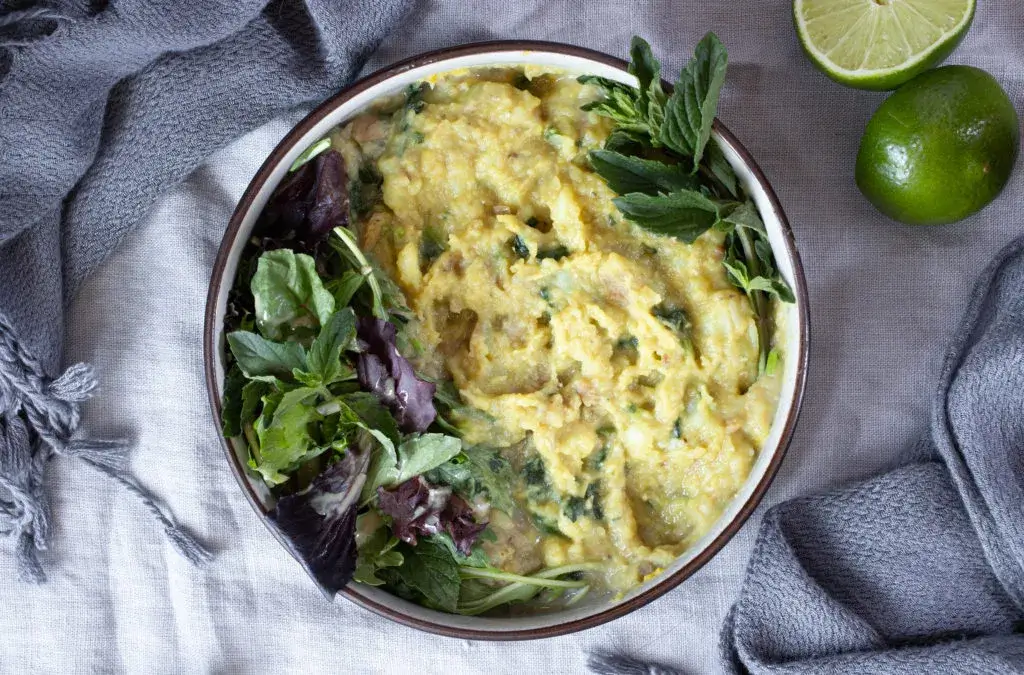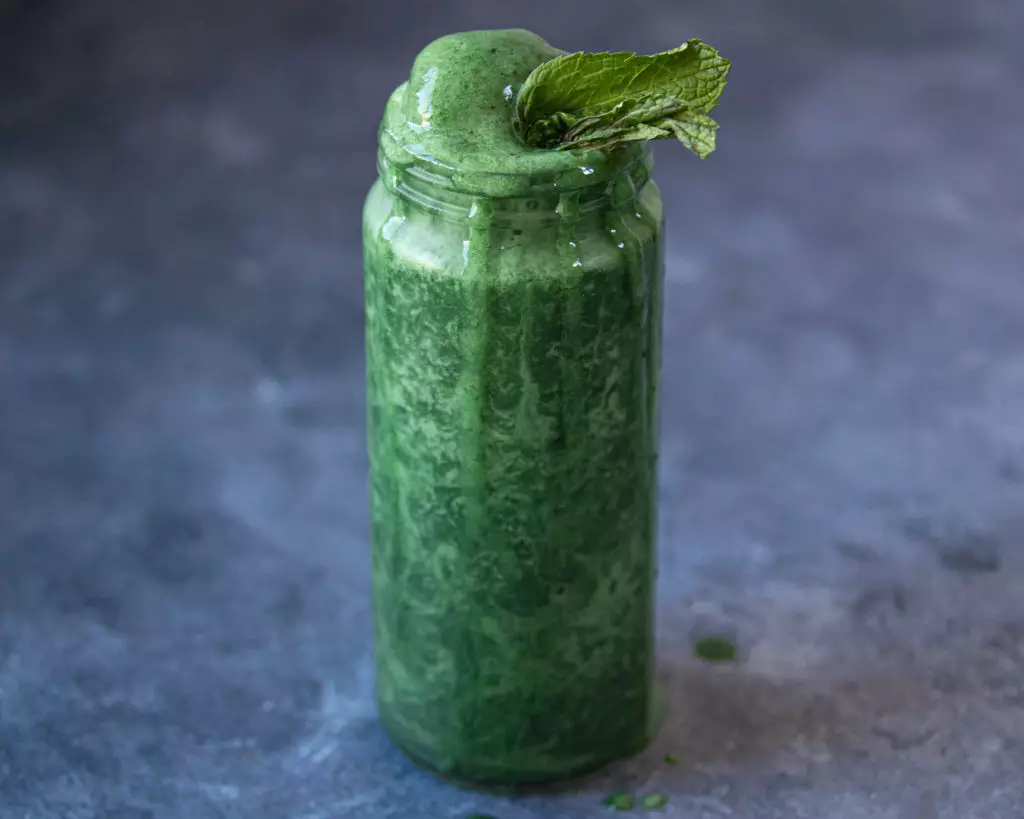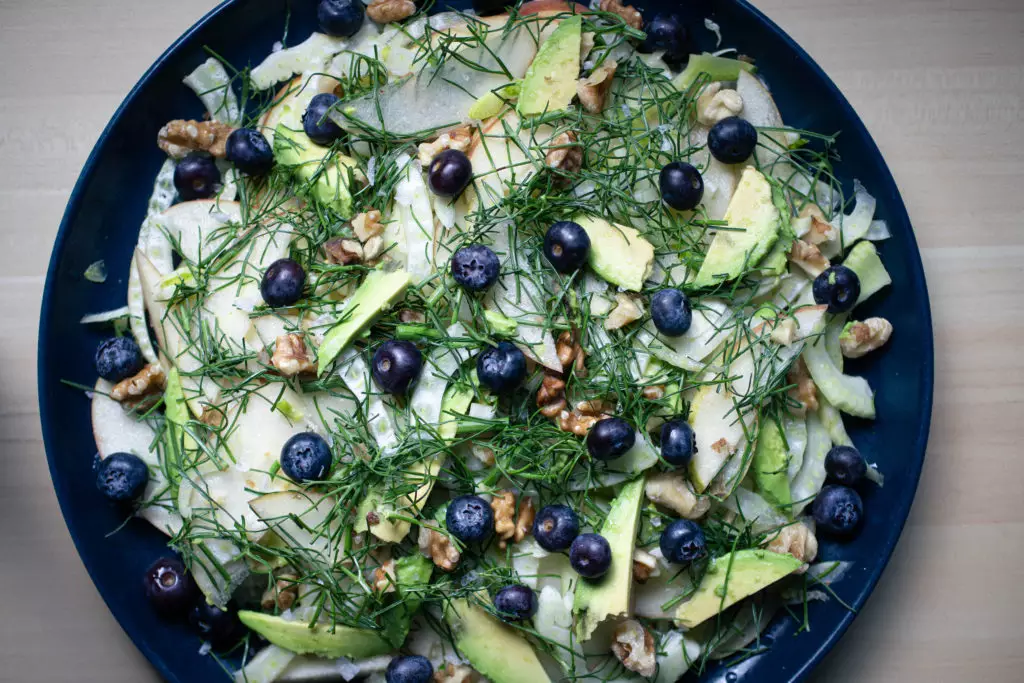Apple Cider Tempeh & Mashed Root Vegetables
These apple cider glazed tempeh strips are just so perfect for autumn–full of fresh apple flavor (the cider really does shine through!), crispy and caramelized on the edges, and possessing a wonderfully meaty bite.
Plus, our little trailer smells like we just came back from apple-picking when I make these which gives me all the good feels. Why is it that apple-picking memories are always the best memories?
So, if you need some cozy, healthy, comforting food–not to mention a hearty protein boost–maybe give these apple cider tempeh strips a try.
I think these apple cider tempeh strips would also make a pretty cool addition to a thanksgiving table for some super seasonal plant-based protein.
Pairing
You could put these apple cider tempeh strips on almost anything. It goes well with autumn salads just But my favorite way to serve them lately is with a mash of sweet potato, carrots, and parsnips. I season it with a little extra virgin olive oil, salt, a little garlic, and plenty of fresh rosemary and thyme and just pile those tempeh strips right on top. The creamy, slightly sweet root vegetable mash with all those savory herbs just feels like the perfect compliment to the chewy, nutty, cider-flavored tempeh strips 🙂
You can also pair the meal with almost any hearty greens. Sauteed kale with olive oil and garlic is one of our favorites. Here, I went for steamed brussel sprouts which I seared just before serving. The whole combination is so delicious.
You can even substitute regular apple juice if you can’t get ahold of cider. But if you can–use some good fresh cider. The freshness really will shine through like the most perfect fall day just wandered right onto your plate.

A note about the vegan protein: Tempeh:
Tempeh is, without a doubt, our favorite vegan protein around here. Not only does it have the most “meaty” texture of all the meat alternatives we’ve tried, it is also very lightly processed (unlike many meat alternatives in the freezer isles) and has the benefit of being fermented–unlike alternative meat products such as tofu (which is made from unfermented soy) or seitan (which is made from gluten).
It also tastes far better than any of the alternatives (in my humble opinion). What do you think?
Read more about the health benefits of tempehWhat is tempeh?
For those who aren’t familiar, tempeh is a traditional Indonesian protein source. It is made by initiating the controlled fermentation (that is, a breakdown by specific microorganisms) of hulled beans, grains, or nuts. However, soybeans are the traditional choice and usually produce the highest protein variation of tempeh. Soy products have been found by studies performed by ____ to reduce total cholesterol, low-density lipoproteins, and triglycerides when consumed as a replacement for animal proteins.
Nutritional composition of tempeh
Soy-based tempeh also contains a host of nutrients. A typical 8 oz serving (at 320 calories) contains not only around 30 grams of protein but also a host of crucial minerals and vitamins.
Minerals:
108% of a human’s daily recommended manganese
46% of your daily recommended (DV) copper;
44% of your daily recommended (DV) phosphorus;
34% (DV) magnesium
Vitamins:
22% DV Niacin
18% DV B6
10% DV Folate
2% DV B12
The role of “anti-nutrients”
Of course, just because soy contains all those nutrients does not mean that those nutrients are easy for the human body to digest. In particular, many pulses, seeds, nuts, and grains (particularly unfermented soybeans) contain compounds which are often referred to as “anti-nutrients.” These compounds (such as phytic acid, tannins, lectins, protase inhibitors, protease inhibitors, and calcium oxyalate) bind with the nutrients in plants to render them less bioavailable when consumed.
This process can be thought of as a self-defense mechanism allowing a plant to protect the nutrients in its seeds. However, for humans, the effect can be sub-optimal. Phytic acid in raw pulses, seeds, nuts, and grains binds together with other nutrients. This renders it difficult for the body to extract the full range of nutrients possible from plants.
Of course, the body will still be able to obtain many nutrients from plants. It just will not be able to extract everything it could. Specifically, anti-nutrients like phytic acid (if not mitigated) can temporarily decrease the body’s absorption of minerals like iron, zinc, and calcium. So, while soy is actually quite high (according to healthline) in all of those minerals (which are crucial for proper blood and fluid balance, nerve function, muscle contraction, and immunity), your body won’t be able to digest many of them unless you can find a way to help break down that phytic acid.
Unlocking the nutrient bioavailability of plants
That’s where processes like fermentation come in. By fermenting soy products, we allow microorganisms to breakdown the anti-nutrients acting as barriers to digestion, rendering the final product more nutritious than its unfermented counterpart.
Actually, there seem to be a few main ways to degrade the anti-nutrients in plants and better access all those good vitamins, minerals, and proteins.
A. Soak grains and cereals overnight when possible. (Now you know why soaking your oats is a cool idea.)
B. Germinate or sprout grains, seeds, and legumes to degrate phytates (one of those pesky anti-nutrients). (I love products like Ezekiel Bread–a bread made of sprouted seeds and grains that together make a complete vegan protein.)
C. Ferment grains, pulses, and seeds (via lactic acid fermentation ideally) to create organic acids that promote phytate breakdown. (Sourdough is a great example of a fermented grain product where the nutrients are made more bioavailable.)
So: Soak. Sprout. Ferment.
A few caveats
Of course, certain processes will be most appropriate for breaking down anti-nutrients in certain plants. And as we process plants, we also often strip away some of the nutrients–leading both to fewer anti-nutrients and fewer nutrients. So it’s important to do your research on each plant individually and make an informed decision about the healthiest way to process it. I’m still learning about all of this myself, so I’d love to hear from you guys if you’ve learned about this.
In sum
In any case, when it comes to tempeh, we ferment the soybeans before cooking them in order to significantly decrease the phytic acid and free up all those vitamins, minerals, and proteins for the body to digest.
Plus, like I said, tempeh is delicious and has a great texture. My meat-loving husband and I adore it equally 🙂 It’s perfect for vegan bolognese, vegan chili, vegan “ribs”, and of course–these delicious apple cider tempeh strips 🙂
(Please note, I’m not a doctor or a dietician–just a human who is very interested in how to eat healthy plant-based diets. Consult your doctor and look into all this research yourself so we can talk about it. I’ve linked above to some of the research I’ve reviewed on this.)
Apple Cider Tempeh & Mashed Root Vegetables
Cut the block of tempeh into 16 small strips.
First, slice the block in half so that you have 2 large steaks about 1/4 inch thick each (half the thickness of the original block).
Then, cut the tempeh into small strips by making 8 cuts in each large piece.
Place the tempeh strips into a bowl and add all the marinade ingredients (apple cider, apple cider vinegar, and maple syrup). Cover the bowl and set it aside for at least 30 minutes. [If you want to prep your tempeh in advance, you can store the tempeh in the marinade for several days.]
Next, prepare the root vegetables for the mash. I never peel my sweet potatoes and carrots (just give them a good wash since the skins contain so many of the nutrients), but parsnips have a tough skin that doesn't mash well so I usually do peel those. Dice the vegetables into small cubes so they will cook faster.
In a medium pot with a lid, add 2 cups of water, a pinch of salt, and all the diced root vegetables. Bring everything to a boil, then reduce the heat, cover the pot, and allow the vegetables to simmer until very very soft (about 30 minutes). They should be easy to mash with a fork before you take them off the heat.
When the tempeh is finished marinating, heat a skillet over medium heat.
A note on pan choice:
Cast iron works best (producing a really nice sear) and will be the easiest to clean.
Ceramic pans will also work but may be slightly more difficult to clean (I make it easier by de-glazing the pan with water soon after I'm finished cooking).
I haven't used stainless steel for this recipe, but I imagine they might be difficult to clean so I would turn off the heat just before all the marinade is completely reduced and begins burning onto the bottom of the pan.
I would avoid using a non-stick skillet as you likely won't be able to get a good caramelized sear on the tempeh.
When the skillet is a little warm but before it becomes hot, add the tempeh strips. Then pour the marinade over the tempeh. Cook the tempeh on medium heat until the marinade has been mostly reduced but a thin layer remains. Check occasionally to ensure the tempeh is not burning on the pan side. Flip the tempeh when it is slightly browned and caramelized on the first side (around 15-20 minutes). Continue to cook on the second side until the marinade is nearly all reduced. Then turn off the heat.
While the tempeh is cooking, finish the root vegetable mash. Strain the water off the cooked veggies but DO NOT DISCARD IT. Keep the starchy potato water, and add 1/3 cup of it back to the veggies along with extra virgin olive oil, garlic, fresh thyme and rosemary, and salt and cracked pepper to taste. Mash until it is as creamy or textured as you like it. Then cover the pot and set it over very low heat until the tempeh is finished cooking. Add a little more starchy potato water if it gets too thick.
Finally, prepare your greens. Steamed brussel sprouts (allow around 10 minutes) or sauteed kale with garlic and extra virgin olive oil (allow 5-7 minutes) are my favorites with this meal.
Load plates with mashed root veggies and top with tempeh strips and greens. Garnish with extra herbs, flakey salt, and sliced avocado 🙂
---
Servings 2
- Amount Per Serving
- Calories 651
- % Daily Value *
- Total Fat 13g20%
- Trans Fat 0g
- Cholesterol 0mg
- Potassium 1644mg47%
- Total Carbohydrate 109g37%
- Dietary Fiber 19g76%
- Sugars 29g
- Protein 28g57%
- Vitamin A 509%
- Vitamin C 19%
- Calcium 60%
- Iron 15%
* Percent Daily Values are based on a 2,000 calorie diet. Your daily value may be higher or lower depending on your calorie needs.
Ingredients
Directions
Cut the block of tempeh into 16 small strips.
First, slice the block in half so that you have 2 large steaks about 1/4 inch thick each (half the thickness of the original block).
Then, cut the tempeh into small strips by making 8 cuts in each large piece.
Place the tempeh strips into a bowl and add all the marinade ingredients (apple cider, apple cider vinegar, and maple syrup). Cover the bowl and set it aside for at least 30 minutes. [If you want to prep your tempeh in advance, you can store the tempeh in the marinade for several days.]
Next, prepare the root vegetables for the mash. I never peel my sweet potatoes and carrots (just give them a good wash since the skins contain so many of the nutrients), but parsnips have a tough skin that doesn't mash well so I usually do peel those. Dice the vegetables into small cubes so they will cook faster.
In a medium pot with a lid, add 2 cups of water, a pinch of salt, and all the diced root vegetables. Bring everything to a boil, then reduce the heat, cover the pot, and allow the vegetables to simmer until very very soft (about 30 minutes). They should be easy to mash with a fork before you take them off the heat.
When the tempeh is finished marinating, heat a skillet over medium heat.
A note on pan choice:
Cast iron works best (producing a really nice sear) and will be the easiest to clean.
Ceramic pans will also work but may be slightly more difficult to clean (I make it easier by de-glazing the pan with water soon after I'm finished cooking).
I haven't used stainless steel for this recipe, but I imagine they might be difficult to clean so I would turn off the heat just before all the marinade is completely reduced and begins burning onto the bottom of the pan.
I would avoid using a non-stick skillet as you likely won't be able to get a good caramelized sear on the tempeh.
When the skillet is a little warm but before it becomes hot, add the tempeh strips. Then pour the marinade over the tempeh. Cook the tempeh on medium heat until the marinade has been mostly reduced but a thin layer remains. Check occasionally to ensure the tempeh is not burning on the pan side. Flip the tempeh when it is slightly browned and caramelized on the first side (around 15-20 minutes). Continue to cook on the second side until the marinade is nearly all reduced. Then turn off the heat.
While the tempeh is cooking, finish the root vegetable mash. Strain the water off the cooked veggies but DO NOT DISCARD IT. Keep the starchy potato water, and add 1/3 cup of it back to the veggies along with extra virgin olive oil, garlic, fresh thyme and rosemary, and salt and cracked pepper to taste. Mash until it is as creamy or textured as you like it. Then cover the pot and set it over very low heat until the tempeh is finished cooking. Add a little more starchy potato water if it gets too thick.
Finally, prepare your greens. Steamed brussel sprouts (allow around 10 minutes) or sauteed kale with garlic and extra virgin olive oil (allow 5-7 minutes) are my favorites with this meal.
Load plates with mashed root veggies and top with tempeh strips and greens. Garnish with extra herbs, flakey salt, and sliced avocado 🙂










[…] if you’re looking for more vegan protein options, I think these apple cider tempeh “ribs” would be an amazing option as well […]